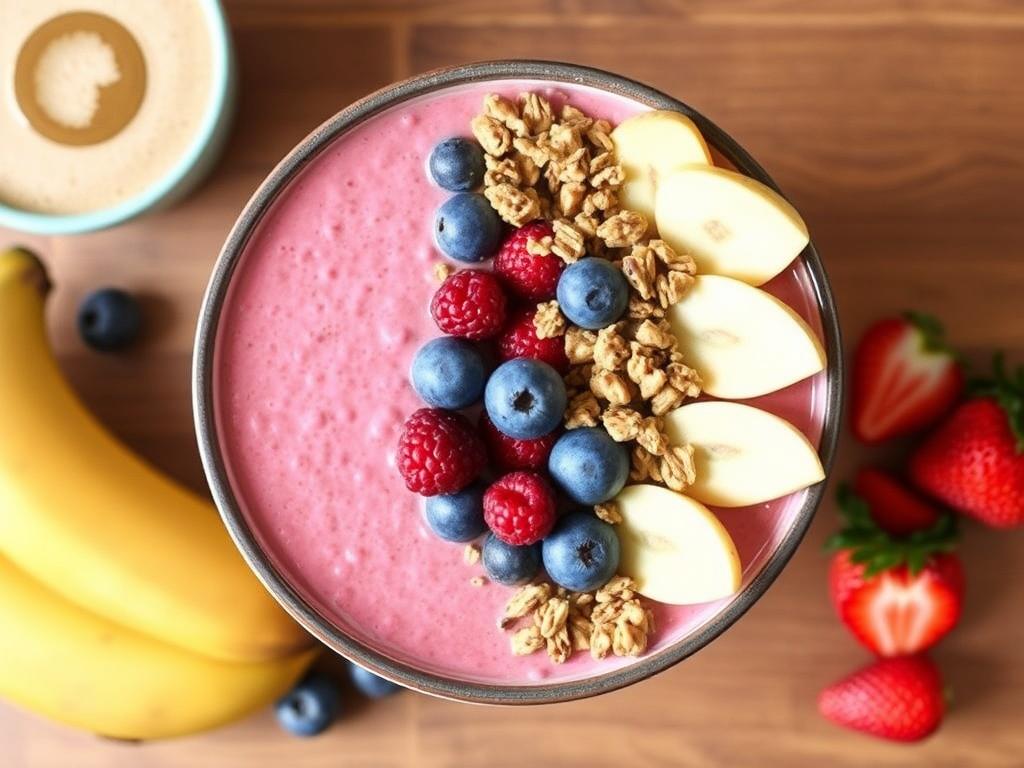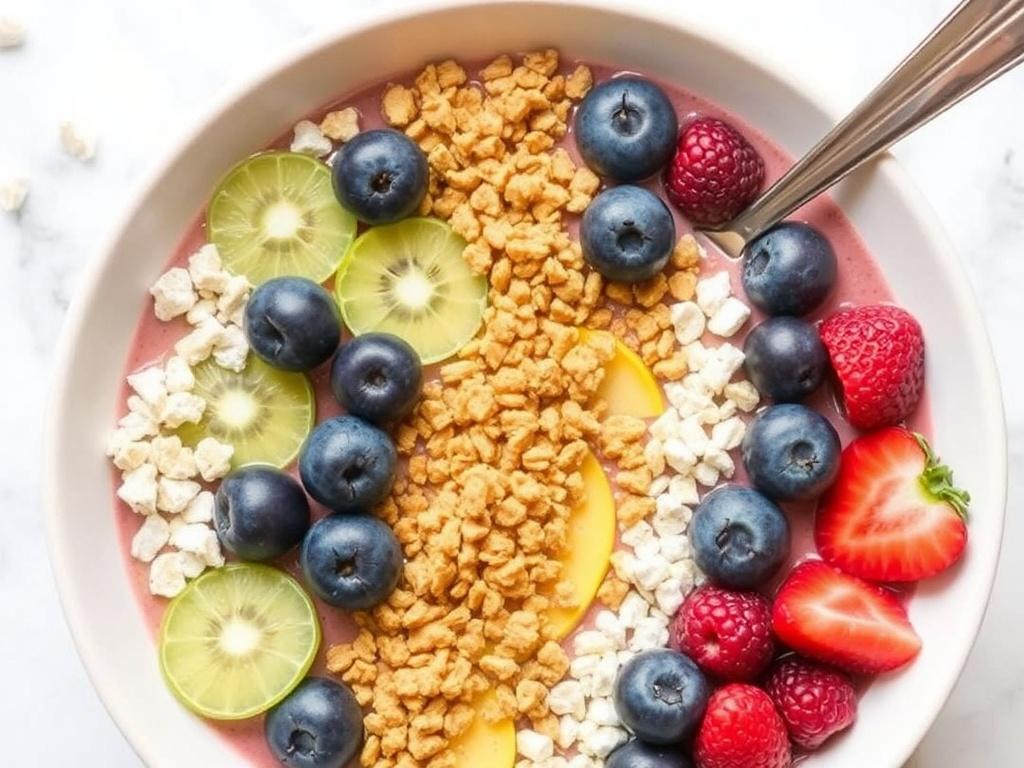When sunlight feels like an ingredient and the market overflows with ripe fruits, few things beat a chilled, colorful bowl at breakfast. Summer Smoothie Bowls are more than a trend; they’re a way to pack fresh produce, cooling textures, and satisfying crunch into a single dish that feels indulgent but moves light. I keep coming back to them because they’re forgiving: there’s room for experiment, for seasonal swaps, for improvisation when the pantry offers only a handful of surprises. This article walks through what makes these bowls sing, how to build texture and nutrition, and gives practical recipes and storage tips that work whether you have ten minutes or half an hour in the morning.
Why smoothie bowls are a great summer breakfast

Start with temperature: a chilled bowl wakes up the senses in hot weather in a way coffee alone cannot. A blended base serves as a canvas for contrasts — creamy against crunchy, tangy against sweet — and that variety keeps the first meal of the day interesting. For many people, a smoothie bowl replaces heavier options without leaving a mid-morning slump; it delivers fiber from fruit and seeds, hydration from coconut water or milk, and a pleasant volume that feels filling.
Beyond personal pleasure, these bowls fit well into warm-season routines. They allow you to use soft, sun-ripened fruit before it spoils and to incorporate leafy greens subtly for a daily dose of vitamins. For anyone who wants quick nourishment without the heat of cooked breakfasts, a smoothie bowl is a summer breakfast winner: fast to prepare, forgiving of small mishaps, and endlessly adaptable to what’s in season.
Building blocks: components that determine texture and flavor
Think of a smoothie bowl as three parts: liquid, frozen solids, and bulking agents. The balance among those parts defines whether you get a pourable smoothie or a spoonable, ice-cream-like texture. Choosing the right liquid and frozen ratio is the first trick; choose too much liquid and you’ll end up with a drink, too little and the blender might struggle. Below I unpack practical choices for each element so you can consistently hit that creamy, scoopable point.
Liquid choices and how they affect the result
Water and coconut water produce a light, refreshing base with clear fruit flavors; plant milks — almond, oat, soy — give a richer, smoother mouthfeel and add subtle sweetness. Yogurt thins the mixture while contributing tang and protein, which helps the bowl keep you satisfied longer. If you’re aiming for a lush, gelato-like texture, use just enough liquid to coax the blades while keeping most of the volume frozen. For a super creamy finish, add a small splash of full-fat coconut milk or a spoonful of nut butter right at the end.
Frozen solids: fruit, vegetables, and more
Frozen bananas are the backbone of many successful bowls: they blend into a custard-like base and mask chill-induced dullness. Berries contribute brightness and antioxidants, mangoes add silkiness and tropical perfume, and frozen cauliflower or zucchini are excellent anonymous thickeners if you want more volume without extra sugar. When freezing fruit, slice it flat on a tray first so it blends evenly. Keep a rotating stash of frozen packs in the freezer — it saves time and makes last-minute bowls feel deliberate rather than accidental.
Thickeners, protein, and body
Chia seeds, oats, and silken tofu are reliable for texture and nutrition; each behaves differently, so match them to the vibe you want. Chia absorbs liquid and adds a gentle gel, oat adds heft and subtle sweetness, and protein powders tighten the texture while boosting satiety. For plant-based protein, consider hemp or pea powders; for an indulgent touch, a spoonful of Greek yogurt or ricotta provides creaminess and calcium. Small amounts go a long way — overdo a thickener and the bowl becomes stodgy rather than lively.
Toppings: the art of contrast and presentation
Toppings make the bowl memorable. They turn a blended mass into a composition of textures and flavors: fresh fruit for juiciness, granola for snap, toasted nuts for aroma. This is where you have the most freedom to be playful. A few carefully chosen elements give both visual appeal and textural balance, which matters when the base is uniform in temperature and density.
Aim for at least three topping components: a fresh fruit, a crunchy element, and a small finishing touch such as a drizzle, herb, or spice. Toasted coconut, cacao nibs, and citrus zest are small additions that transform the bowl from ordinary to distinct. And remember: the bowl should invite a spoonful that includes at least two contrasting textures so every bite has variety.
- Fresh fruit: berries, sliced stone fruit, kiwi
- Crunch: granola, toasted oats, chopped pistachios
- Seeds and small bites: chia, hemp hearts, cacao nibs
- Drizzles: honey, date syrup, tahini
- Herbs and spices: mint, basil, cinnamon, flaky salt
Three seasonal recipes to get started
Below are three bowls that showcase different personalities: bright and tart, tropical and creamy, green and herbaceous. I include ingredient ratios and brief steps so you can replicate results without weighing each element. Each recipe assumes you have a powerful blender or a food processor with a tamper; adapt timing to your machine and frozen fruit texture.
| Recipe | Main Frozen Ingredients | Liquid | Key Toppings |
|---|---|---|---|
| Berry Lemon Sunrise | 1 cup frozen mixed berries, 1 frozen banana | 1/3 cup almond milk + splash lemon juice | Fresh raspberries, granola, lemon zest |
| Mango Coconut Breeze | 1 cup frozen mango, 1/2 frozen banana | 1/3 cup coconut water + 2 tbsp coconut milk | Toasted coconut, chia, lime wedges |
| Green Mint Revival | 1 cup frozen spinach + 1 frozen banana | 1/2 cup oat milk + sprig mint | Sliced green apple, pumpkin seeds, a drizzle of honey |
Berry Lemon Sunrise: method and notes
Combine the frozen berries and banana with almond milk in a blender. Start on low speed and increase, using short pulses to break down the fruit; if the blades stall, add a tablespoon of liquid at a time. Stir in a little lemon juice to brighten the berries, then scoop into a bowl and top with granola and a fine grate of lemon zest. The contrast of tart lemon with sweet berries keeps the bowl from feeling cloying, and the granola adds the satisfying crunch that late-summer mornings demand.
Mango Coconut Breeze: method and notes
This one leans tropical and creamy. Blend the frozen mango with coconut water and a small amount of coconut milk; the latter lends silkiness without overwhelming the fruit. Toast coconut flakes in a dry pan for a minute to wake up their flavor and scatter over the finished bowl with chia seeds for gentle texture. A squeeze of lime just before serving sharpens the sweetness and gives the bowl a lift that pairs well with ocean-side breakfasts or a backyard brunch.
Green Mint Revival: method and notes
Frozen greens can be intimidating, but when combined with banana and oat milk they melt into a pleasantly pale, herbaceous base. Use a fresh sprig of mint in the blender for a clean aromatic note and balance the greens with a bit of honey if required. Top with tart apple slices and toasted pumpkin seeds for a range of textures and a hint of savory crunch. This bowl is a good example of how vegetable-forward bases can still feel approachable and bright.
Make-ahead, storage, and transportation tricks
Preparing smoothie bowls in advance changes the morning entirely. Freeze individual portions in small airtight containers; when you’re ready, let them sit at room temperature for a few minutes then blitz in a blender with a tablespoon or two of liquid to revive them. You can also keep pre-made dry topping jars arranged by flavor profile — citrus-berry, tropical, nutty — so assembly becomes a quick, almost ceremonial act.
If you plan to take a bowl on the go, consider a layered approach: pour the base into an insulated jar and pack crunchy toppings separately in a little container. Add them at the last minute to preserve texture. For travel, choose more robust toppings — nuts, seeds, coconut — that won’t wilt or weep quickly during transit.
Pairings and serving ideas for different occasions
For a light brunch, pair a smoothie bowl with a small savory bite: a slice of avocado toast or a soft-boiled egg balances the sweetness and adds protein. If serving for a small group, offer a build-your-own topping station with bowls of fruit, granola, nuts, and sweet drizzles so guests can customize. In hot climates, serve the bowls in chilled ceramic dishes to prolong the cold sensation and keep textures crisp for longer.
I remember a summer morning by a lake when I made a batch for friends: the bowls felt festive, partly because we ate from mismatched bowls and partly because the fruit had the intense flavor only July can deliver. That casual moment taught me that smoothie bowls work socially too — they invite conversation and small acts of creativity as people assemble their own finishes.
Nutrition considerations and easy swaps
These bowls can range from dessert-like to nutritionally balanced, so be deliberate. To boost protein, add Greek yogurt, a scoop of protein powder, or a spoonful of nut butter. For more fiber and sustained fullness, include oats or extra chia seeds in the base. If sugar intake is a concern, favor lower-sugar fruits like berries and green apple, and use unsweetened plant milks instead of sweetened varieties.
Simple swaps make a big difference: replace granola with toasted oats to reduce added sugars, choose unsweetened coconut flakes over sweetened ones, and prefer whole fruit to fruit juice or large quantities of dried fruit. Small choices like these keep the bowls nourishing while preserving their appeal as a treat-like breakfast.
Making bowls appealing to kids and picky eaters
Children often respond to color and involvement. Let them help pick the toppings and sprinkle them on; a small role in assembling a bowl increases the chance they will eat it. Smooth textures and familiar fruits — banana, strawberry, mango — are safer bets than a bowl heavy with greens. You can mask mild greens by pairing them with strong-flavored fruits and a scoop of yogurt, keeping both nutrition and taste-friendly.
Practical troubleshooting and blender tips
If your blender struggles, pre-thaw frozen fruit for five minutes or add a tablespoon of warm water to loosen the blades’ grip. Use a tamper if your blender has one, and pulse rather than run on high continuously to avoid overheating and losing the frosty texture. Clean your blender right away: a quick rinse and a spin with warm water and a drop of dish soap keeps residues from building up and makes mornings simpler.
Final thoughts and a nudge to experiment
Summer Smoothie Bowls are a small ritual that can make busy mornings feel intentionally pleasurable. They invite experimentation, respect seasonality, and reward small investments of time with immediate sensory returns. Start with the simple recipes here, then tweak proportions and toppings until you find a personal rhythm. Keep a few staple frozen packs and topping jars ready, and you’ll discover that these bowls become one of the most reliable and delightful parts of a summer routine. Try making one this week, and notice how a chilled, colorful breakfast changes the pace of the day.
